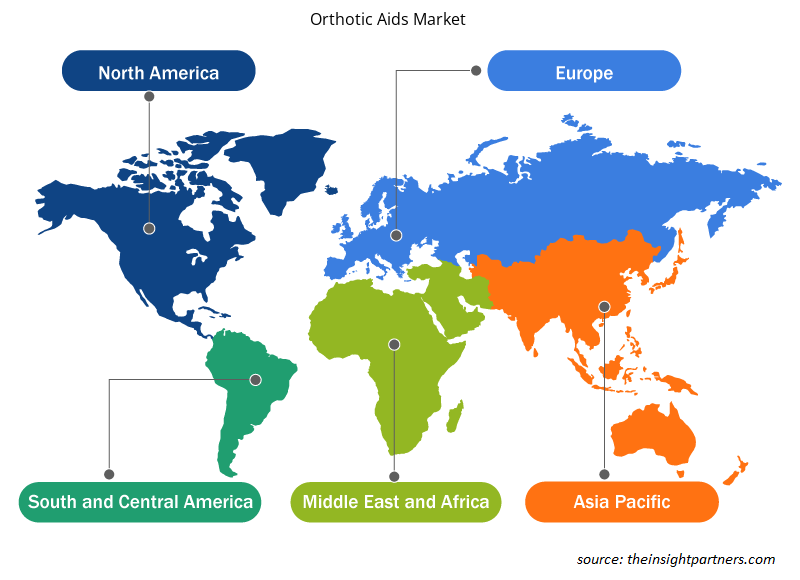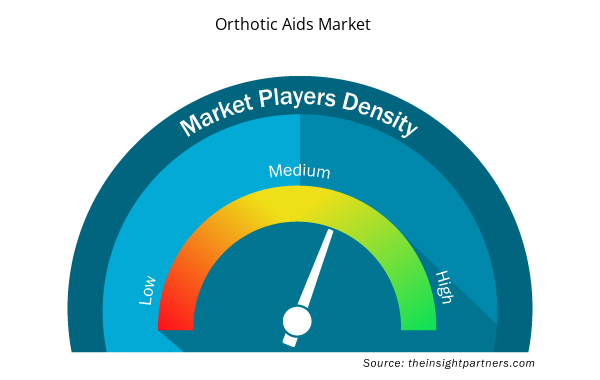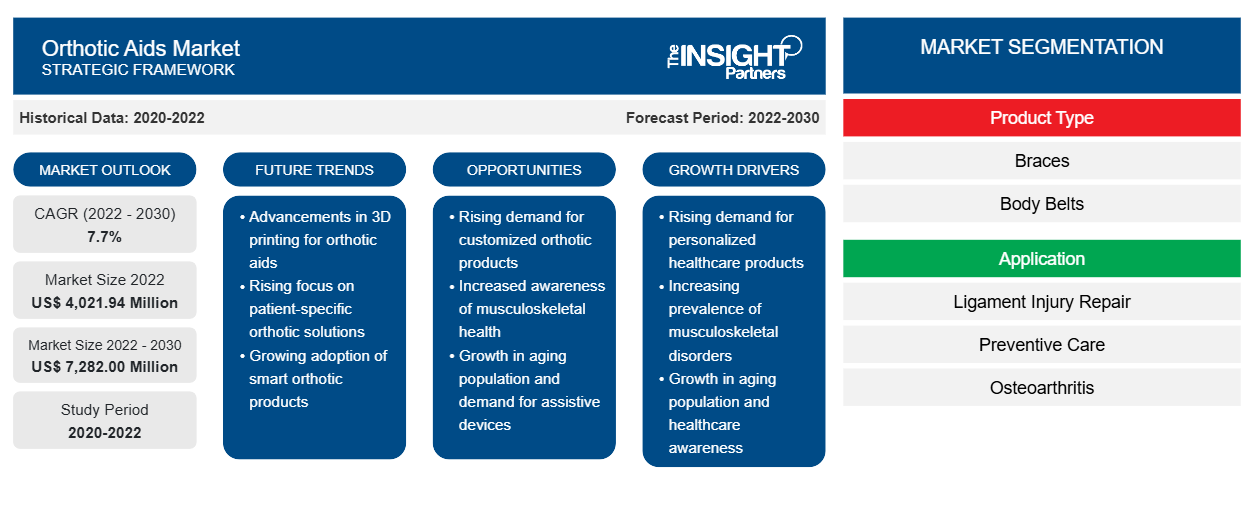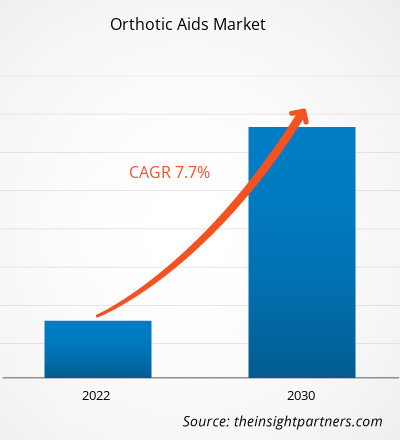[調査レポート] 矯正補助器具の市場規模は、2022年の40億2,194万米ドルから2030年までに72億8,200万米ドルに達すると予測されており、2022年から2030年にかけて市場は7.7%のCAGRを記録すると予測されています。
市場洞察とアナリストの見解:
矯正補助具は、筋骨格系をサポートし、安定性を与え、変形を防止、矯正、または整列させ、身体部分の機能を改善するために使用される装置です。一般的に使用される矯正補助具には、足矯正器具、膝装具、背部装具、手首装具、足首装具などがあります。世界レベルで大規模な人口の間で整形外科的疾患が急増しているため、矯正補助具の需要が高まっています。さらに、矯正器具市場のプレーヤーによる製品の発売、技術の進歩、戦略的コラボレーションの増加により、今後数年間で矯正補助具市場の成長が拡大する可能性があります。
成長の原動力:
ボディベルトやブレースなどの整形補助具は、脳性麻痺、脳損傷、脊髄損傷、その他の神経/整形外科的疾患に苦しむ患者の運動能力とサポートに役立ちます。米国疾病管理予防センターによると、米国では2020年に外傷性脳損傷(TBI)関連の入院が約214,110件、TBI関連の死亡が69,473件報告されています。そのため、さまざまな整形外科的および神経学的疾患に苦しむ患者数の増加に伴い、整形補助具の使用が増加しています。
医療施設の近代化と医療サービスの向上は、最終的には人々の平均寿命を延ばすことになりますが、その結果、世界の高齢者人口が増加しています。高齢者は転倒のリスクが高く、加齢とともに筋肉や骨がすり減る傾向があるため、ちょっとした事故でも骨折や骨折を引き起こす可能性があります。高齢者に影響を及ぼす可能性のある骨粗しょう症やその他の症状は、骨折のリスクをさらに高める可能性があります。したがって、高齢者人口の増加は、整形外科的傷害や障害の急増と相関しており、矯正補助具の需要を生み出しています。変形性関節症(OA)アクションアライアンスによると、米国では、OA患者の88%が45歳以上、43%が65歳以上です。
脳性麻痺、二分脊椎、筋ジストロフィー、内反足などの整形外科的および神経筋疾患により、子供の筋骨格系が発達して動きや姿勢が困難になる場合があります。米国疾病予防管理センター (CDC) によると、内反足は米国で最も一般的な先天性障害の 1 つであり、2022 年には国内で約 6,643 人の赤ちゃんが影響を受けました。小児装具療法では、特殊な矯正器具または装具を使用して、子供の体の関節、特に脊椎、股関節、膝、足首、足の関節をサポートして整列させます。これらの器具は診断後に処方され、通常は患者のニーズに合わせて製造されます。
したがって、さまざまな年齢層の人々の間で矯正補助具の使用が増えることで、矯正補助具市場の成長が促進されます。
保険適用範囲が一貫していなかったり、製品適用範囲が限られていると、患者の負担が増大します。矯正治療や補助器具の高額な費用と、不利な償還方針が、矯正補助器具市場の成長を妨げています。慢性的な痛みやけがに苦しむ高齢者は、背中用装具から大きな恩恵を受けることができます。耐久性のある腕、脚、首、背中の装具は、いくつかの制限付きでメディケア パート B でカバーされます。メディケアの装具給付は、膝装具をカバーします。この給付の対象となるには、装具は半剛性または剛性の装置で、弱いまたは変形した身体部分をサポートするか、または身体の病気またはけがをした部分の動きを制限するか完全に排除するために使用されます。装具給付の法定定義は、意図された身体部分を固定またはサポートできるほど剛性が十分でない品目には適用されません。装具の説明に当てはまらない品目はカバーされず、このメディケア給付の給付対象にはなりません。
要件に合わせてレポートをカスタマイズする
このレポートの一部、国レベルの分析、Excelデータパックなど、あらゆるレポートを無料でカスタマイズできます。また、スタートアップや大学向けのお得なオファーや割引もご利用いただけます。
- このレポートの主要な市場動向を入手してください。この無料サンプルには、市場動向から見積もりや予測に至るまでのデータ分析が含まれます。
レポートのセグメンテーションと範囲:
「矯正補助器具市場」は、製品タイプ、用途、流通チャネル、サプライヤータイプ、および地域に基づいてセグメント化されています。製品タイプに基づいて、矯正補助器具市場はブレース、ボディベルト、その他に分類されています。用途に関しては、矯正補助器具市場は靭帯損傷修復、予防ケア、変形性関節症、圧迫療法、その他に分類されています。流通チャネルに基づいて、市場はオンラインとオフラインに分かれています。矯正補助器具市場は、サプライヤータイプ別に、ブランドと非ブランドに分かれています。地理に基づいて、矯正補助具市場は、北米(米国、カナダ、メキシコ)、欧州(ドイツ、英国、フランス、イタリア、スペイン、その他の欧州)、アジア太平洋(中国、日本、インド、オーストラリア、韓国、その他のアジア太平洋)、中東およびアフリカ(サウジアラビア、南アフリカ、UAE、その他の中東およびアフリカ)、および中南米(ブラジル、アルゼンチン、その他の中南米)に分類されます。
セグメント分析:
矯正補助具市場は、製品タイプ別に、ブレース、ボディベルト、その他に分類されます。ブレースセグメントは、2022年に最大の市場シェアを占めました。同じセグメントは、2022年から2030年の間に最高のCAGRを記録すると予想されています。背中牽引ベルト、弾性背中ブレース、銅ベルト、腰痛ベルト、背中ブレースなどのボディベルトは、関節の捻挫、筋肉の緊張、および怪我の治療に一般的に使用されます。ほとんどの人は、人生のある時点で腰痛を経験する可能性があります。怪我や病気は腰痛のいくつかの原因の1つですが、症例の大部分は重いものを不適切に持ち上げたり、姿勢が悪かったりすることから生じます。背中ブレースを着用することは、腰痛を予防し、姿勢を改善するための一般的な方法です。Cross River Therapyによると、10人中8人のアメリカ人が、1年に少なくとも1回以上背中の問題を抱えていると報告しています。同じ情報源によると、8,000万人の労働者、つまり就労しているアメリカ人の50%が毎年腰痛を報告しています。
用途に基づいて、矯正補助具市場は、靭帯損傷修復、予防ケア、変形性関節症、圧迫療法、その他に分類されます。靭帯損傷修復セグメントは2022年に最大の市場シェアを占め、2022年から2030年にかけて最高のCAGRを記録すると予想されています。内側側副靭帯(MCL)、後十字靭帯(PCL)、前十字靭帯(ACL)、および外側側副靭帯(LCL)は、膝の4つの主要な靭帯です。靭帯は人の膝を動かし続けるために役立ち、中程度の軽傷でも人に大きな不快感を与える可能性があります。膝ブレースは膝への負荷を軽減できます。部分断裂の場合、医師はACLブレースと筋力強化のための理学療法を使用して、非外科的にACL断裂を修復することを推奨する場合があります。ただし、手術を受ける患者の場合、医師は十分に治癒するまで術後の膝装具と松葉杖の着用を推奨しています。ACL 断裂のリハビリテーションは比較的長く、完了するまでに 6 か月から 1 年かかることがあります。回復後、患者はスポーツをする際に ACL 膝装具を着用するよう勧められることがあります。
PCL 断裂は、グレード 1 断裂、グレード 2 断裂、グレード 3 断裂、健康な PCL の 4 つのグループに分類されます。断裂が重度の場合、患者は PCL 手術を受ける必要があります。手術後は、術後の回復のために PCL 膝装具を着用することが推奨されます。Brace Ability では、PCL 断裂の予防と治療のための装具やサポーターを多数取り揃えています。MCL 損傷の大部分は、氷を当て、抗炎症薬を服用し、休息することで自宅で治療できます。医師は、患者の膝を保護し、ある程度の動きを可能にする装具を勧める場合があります。断裂が著しく重度の場合、患者は手術を受ける必要がある場合があります。
流通チャネルに基づいて、矯正補助具市場はオンラインとオフラインに分かれています。オフラインセグメントは2022年に大きな市場シェアを占めました。ただし、オンラインセグメントは2022年から2030年の間により高いCAGRを記録すると予想されています。オンライン薬局では、顧客が実際の店舗を訪れることなく処方薬、医療機器、電子サービスを購入できるため、自宅で迅速かつ快適に薬やサービスを受け取ることができます。インターネットの普及、デジタル化、政府の支援、経済の活況などは、オンライン流通チャネルを通じて矯正補助具市場の成長に貢献する主な要因です。たとえば、ウォルマートやメディカルデパートメントストア社は、装具、ボディベルト、アームスリングなどを提供するオンラインディストリビューターの一部です。
サプライヤーの種類に基づいて、矯正補助具市場はブランドと非ブランドの2つに分かれています。ブランドセグメントは2022年に市場の大きなシェアを占めましたが、非ブランドセグメントは2022年から2030年の間により高いCAGRを記録すると予想されています。ブランド矯正補助具には、世界的に大きな存在感を持つ有名メーカーが製造した製品が含まれます。これらの製品は、オンラインおよびオフラインの流通チャネルを通じて入手できます。米国は世界で2番目に大きな膝装具の輸入国であり、その膝装具の大部分を中国、ベトナム、ベルギーから調達しています。発展途上国ではメーカーの数が限られており、消費者の購買力が高まっているため、ブランド品のメーカーは進化する消費者のニーズを満たす製品を提供するよう促されています。
地域分析:
世界の矯正補助具市場は、北米、ヨーロッパ、アジア太平洋、中東およびアフリカ、南米および中米に区分されています。北米は、大規模な人口の間で整形外科的疾患の有病率が増加していること、およびそのような疾患にかかりやすい高齢者人口が急増していることから、大きな市場シェアを占めると予想されています。さらに、製品の発売、地理的拡大、および技術の進歩により、この地域の矯正補助具市場の成長が将来的に促進されると予想されています。北米の矯正補助具市場は、米国、カナダ、メキシコに区分されています。米国が大きな市場シェアを占めています。変形性関節症アクションアライアンス(OAAA)は、関節炎は米国で深刻な健康危機であると述べています。米国疾病管理予防センター(CDC)の推計によると、2019年から2021年の間に国内の5,320万人の成人(つまり、約25%または4人に1人)が何らかの関節炎に苦しんでおり、その数は2040年までに7,800万人に達すると予想されています。関節炎および関連疾患には100種類以上の形態があります。変形性関節症(OA)の患者は、同年代の人よりも顕著な痛み、障害、疲労、および活動制限を経験します。慢性および断続的な痛みは、機能障害および仕事の制限につながる可能性があります。関節炎は、1つまたは複数の関節の圧痛と腫れが特徴です。関節炎の主な症状には、一般的に加齢とともに悪化するこわばりと関節痛があります。膝ブレースなどの矯正器具は、薬を使用せずに痛みを和らげ、関節や体の一部を保護およびサポートするのに役立ちます。背中用ブレースは筋肉と上半身を強化し、骨粗鬆症による骨折のリスクを軽減します。
米国における脊髄損傷の発生率の急増は、装具市場を活性化させています。米国神経外科学会によると、米国では毎年約17,000件の新たな脊髄損傷が発生しています。全米多発性硬化症協会は、2020年に米国で約100万人が多発性硬化症に罹患したと述べています。したがって、脊髄損傷と多発性硬化症によって引き起こされる障害は、結果としてこれらの患者の移動を支援する装具の必要性をもたらします。脊髄損傷(SCI)を患っている患者には、医師が装具の使用を推奨しています。装具は、外部から脊椎の位置を適切に調整し、軟部組織(靭帯など)では脊椎を安定させられない場合に脊椎を安定させ、矯正力を加え、動きを制限します。
アジア太平洋地域は、2022年から2030年の間に矯正補助具市場で大幅なCAGRを記録すると予想されています。予測される市場の成長は、さまざまな整形外科的状態に陥りやすい高齢者人口の増加に起因しています。中国は高齢者人口が最も多い国の一つです。Population Reference Bureau 2023によると、中国の高齢者人口は2050年までに3億6,600万人に達すると予想されており、これは米国よりも大幅に多い数です。さらに、市場プレーヤー間のコラボレーション、技術の進歩、製品の発売により、アジア太平洋地域の矯正補助具市場の成長がさらに促進されるでしょう。2023年1月、Breg, Inc.は医療機器サプライヤーのCoreal Internationalと提携し、同社の幅広いブレースおよび寒冷療法製品のポートフォリオを中国の医師とその患者に提供しました。
矯正補助器具市場の地域別分析
予測期間を通じて装具補助器具市場に影響を与える地域的な傾向と要因は、Insight Partners のアナリストによって徹底的に説明されています。このセクションでは、北米、ヨーロッパ、アジア太平洋、中東、アフリカ、南米、中米にわたる装具補助器具市場のセグメントと地域についても説明します。

- 矯正補助器具市場の地域別データを入手
矯正補助具市場レポートの範囲
| レポート属性 | 詳細 |
|---|---|
| 2022年の市場規模 | 40億2,194万米ドル |
| 2030年までの市場規模 | 72億8,200万米ドル |
| 世界のCAGR(2022年 - 2030年) | 7.7% |
| 履歴データ | 2020-2022 |
| 予測期間 | 2022-2030 |
| 対象セグメント | 製品タイプ別
|
| 対象地域と国 | 北米
|
| 市場リーダーと主要企業プロフィール |
|
市場プレーヤーの密度:ビジネスダイナミクスへの影響を理解する
矯正補助器具市場は、消費者の嗜好の変化、技術の進歩、製品の利点に対する認識の高まりなどの要因により、エンドユーザーの需要が高まり、急速に成長しています。需要が高まるにつれて、企業は提供品を拡大し、消費者のニーズを満たすために革新し、新たなトレンドを活用し、市場の成長をさらに促進しています。
市場プレーヤー密度とは、特定の市場または業界内で活動している企業または会社の分布を指します。これは、特定の市場スペースに、その規模または総市場価値と比較して、どれだけの競合相手 (市場プレーヤー) が存在するかを示します。
矯正補助具市場で事業を展開している主要企業は次のとおりです。
- オズールHF
- オットーボック SE & Co KGaA
- トゥアスネSAS
- フィラウアーLLC
- ローマン&ラウッシャー GmbH & Co KG
免責事項:上記の企業は、特定の順序でランク付けされていません。

- 矯正補助器具市場のトップキープレーヤーの概要を入手
業界の発展と将来の機会:
矯正補助具市場で活動する主要企業が行っているさまざまな取り組みを以下に示します。
- 2023年10月、OrthoPediatrics Corp.は、非外科的事業の拡大の一環としてDF2ブレースを発売しました。この製品は、筋骨格系の損傷を負った子供の治療に適応しています。このブレースは、生後6か月から5歳までの小児患者の大腿骨骨折固定におけるスパイカギプスの代わりとなるもので、大腿骨、膝、股関節の固定を可能にします。
- 2021 年 2 月、Breg, Inc. は、Pinnacle と Ascend という 2 つの新しい脊椎矯正器具のラインを発売しました。これら 2 つのラインは合計 15 の製品で構成されており、脊椎損傷患者のケアを向上させるように設計されています。
競争環境と主要企業:
Ossur hf、Ottobock SE & Co KGaA、Thuasne SAS、Fillauer LLC、Lohmann & Rauscher GmbH & Co KG、DeRoyal Industries Inc、Hanger Inc、Steeper Group Holdings Ltd、Breg Inc、および DJO LLC は、著名な矯正補助具会社です。これらの会社は、新しい技術、既存製品の改良、および地理的拡大に注力し、世界中で高まる消費者の需要に対応しています。
- 過去2年間の分析、基準年、CAGRによる予測(7年間)
- PEST分析とSWOT分析
- 市場規模価値/数量 - 世界、地域、国
- 業界と競争環境
- Excel データセット


- Vertical Farming Crops Market
- Influenza Vaccines Market
- Visualization and 3D Rendering Software Market
- Micro-Surgical Robot Market
- Wire Harness Market
- Investor ESG Software Market
- Point of Care Diagnostics Market
- Public Key Infrastructure Market
- Portable Power Station Market
- Medical Audiometer Devices Market

Report Coverage
Revenue forecast, Company Analysis, Industry landscape, Growth factors, and Trends

Segment Covered
This text is related
to segments covered.

Regional Scope
North America, Europe, Asia Pacific, Middle East & Africa, South & Central America

Country Scope
This text is related
to country scope.
よくある質問
The devices or supports known as orthotic aids are intended to enhance the sustainability and functionality of various body parts, usually the musculoskeletal system. These tools are frequently employed to address problems like pain, damage, or deformity. Common orthotic aids include orthotic insoles, ankle braces, knee braces, back braces, wrist braces, shoulder braces, neck braces, prosthetic limbs, spinal orthoses, etc. Orthotic devices have been shown to reduce pain and enhance people's quality of life significantly.
The global orthotic aids market is analyzed based on product type, application, type of supplier, and distribution channel. Based on product type, braces segment dominates the market growth during 2022-2030.
The growth of the global orthotic aids market is attributed to a few key factors, such as increasing prevalence of orthopedic conditions among people of different age groups. Additionally, the rising number of strategic collaborations and product launches by market players is expected to contribute to the orthotic aids market proliferation in the future.
The global orthotic aids market segmented into North America, Europe, Asia Pacific, Middle East & Africa, and South & Central America. North America is expected to dominate the market in terms of market share however, Asia Pacific is expected to register the highest growth rate during 2022-2030.
The global orthotic aids market majorly consists of the players such as Ossur hf, Ottobock SE & Co KGaA, Thuasne SAS, Fillauer LLC, Lohmann & Rauscher GmbH & Co KG, DeRoyal Industries Inc, Hanger Inc, Steeper Group Holdings Ltd, Breg Inc, and DJO LLC.
Trends and growth analysis reports related to Life Sciences : READ MORE..
The List of Companies - Orthotic Aids Market
- Ossur hf
- Ottobock SE & Co KGaA
- Thuasne SAS
- Fillauer LLC
- Lohmann & Rauscher GmbH & Co KG
- DeRoyal Industries Inc
- Hanger Inc
- Steeper Group Holdings Ltd
- Breg Inc
- DJO LLC
The Insight Partners performs research in 4 major stages: Data Collection & Secondary Research, Primary Research, Data Analysis and Data Triangulation & Final Review.
- Data Collection and Secondary Research:
As a market research and consulting firm operating from a decade, we have published and advised several client across the globe. First step for any study will start with an assessment of currently available data and insights from existing reports. Further, historical and current market information is collected from Investor Presentations, Annual Reports, SEC Filings, etc., and other information related to company’s performance and market positioning are gathered from Paid Databases (Factiva, Hoovers, and Reuters) and various other publications available in public domain.
Several associations trade associates, technical forums, institutes, societies and organization are accessed to gain technical as well as market related insights through their publications such as research papers, blogs and press releases related to the studies are referred to get cues about the market. Further, white papers, journals, magazines, and other news articles published in last 3 years are scrutinized and analyzed to understand the current market trends.
- Primary Research:
The primarily interview analysis comprise of data obtained from industry participants interview and answers to survey questions gathered by in-house primary team.
For primary research, interviews are conducted with industry experts/CEOs/Marketing Managers/VPs/Subject Matter Experts from both demand and supply side to get a 360-degree view of the market. The primary team conducts several interviews based on the complexity of the markets to understand the various market trends and dynamics which makes research more credible and precise.
A typical research interview fulfils the following functions:
- Provides first-hand information on the market size, market trends, growth trends, competitive landscape, and outlook
- Validates and strengthens in-house secondary research findings
- Develops the analysis team’s expertise and market understanding
Primary research involves email interactions and telephone interviews for each market, category, segment, and sub-segment across geographies. The participants who typically take part in such a process include, but are not limited to:
- Industry participants: VPs, business development managers, market intelligence managers and national sales managers
- Outside experts: Valuation experts, research analysts and key opinion leaders specializing in the electronics and semiconductor industry.
Below is the breakup of our primary respondents by company, designation, and region:

Once we receive the confirmation from primary research sources or primary respondents, we finalize the base year market estimation and forecast the data as per the macroeconomic and microeconomic factors assessed during data collection.
- Data Analysis:
Once data is validated through both secondary as well as primary respondents, we finalize the market estimations by hypothesis formulation and factor analysis at regional and country level.
- Macro-Economic Factor Analysis:
We analyse macroeconomic indicators such the gross domestic product (GDP), increase in the demand for goods and services across industries, technological advancement, regional economic growth, governmental policies, the influence of COVID-19, PEST analysis, and other aspects. This analysis aids in setting benchmarks for various nations/regions and approximating market splits. Additionally, the general trend of the aforementioned components aid in determining the market's development possibilities.
- Country Level Data:
Various factors that are especially aligned to the country are taken into account to determine the market size for a certain area and country, including the presence of vendors, such as headquarters and offices, the country's GDP, demand patterns, and industry growth. To comprehend the market dynamics for the nation, a number of growth variables, inhibitors, application areas, and current market trends are researched. The aforementioned elements aid in determining the country's overall market's growth potential.
- Company Profile:
The “Table of Contents” is formulated by listing and analyzing more than 25 - 30 companies operating in the market ecosystem across geographies. However, we profile only 10 companies as a standard practice in our syndicate reports. These 10 companies comprise leading, emerging, and regional players. Nonetheless, our analysis is not restricted to the 10 listed companies, we also analyze other companies present in the market to develop a holistic view and understand the prevailing trends. The “Company Profiles” section in the report covers key facts, business description, products & services, financial information, SWOT analysis, and key developments. The financial information presented is extracted from the annual reports and official documents of the publicly listed companies. Upon collecting the information for the sections of respective companies, we verify them via various primary sources and then compile the data in respective company profiles. The company level information helps us in deriving the base number as well as in forecasting the market size.
- Developing Base Number:
Aggregation of sales statistics (2020-2022) and macro-economic factor, and other secondary and primary research insights are utilized to arrive at base number and related market shares for 2022. The data gaps are identified in this step and relevant market data is analyzed, collected from paid primary interviews or databases. On finalizing the base year market size, forecasts are developed on the basis of macro-economic, industry and market growth factors and company level analysis.
- Data Triangulation and Final Review:
The market findings and base year market size calculations are validated from supply as well as demand side. Demand side validations are based on macro-economic factor analysis and benchmarks for respective regions and countries. In case of supply side validations, revenues of major companies are estimated (in case not available) based on industry benchmark, approximate number of employees, product portfolio, and primary interviews revenues are gathered. Further revenue from target product/service segment is assessed to avoid overshooting of market statistics. In case of heavy deviations between supply and demand side values, all thes steps are repeated to achieve synchronization.
We follow an iterative model, wherein we share our research findings with Subject Matter Experts (SME’s) and Key Opinion Leaders (KOLs) until consensus view of the market is not formulated – this model negates any drastic deviation in the opinions of experts. Only validated and universally acceptable research findings are quoted in our reports.
We have important check points that we use to validate our research findings – which we call – data triangulation, where we validate the information, we generate from secondary sources with primary interviews and then we re-validate with our internal data bases and Subject matter experts. This comprehensive model enables us to deliver high quality, reliable data in shortest possible time.


 このレポートの無料サンプルを入手する
このレポートの無料サンプルを入手する